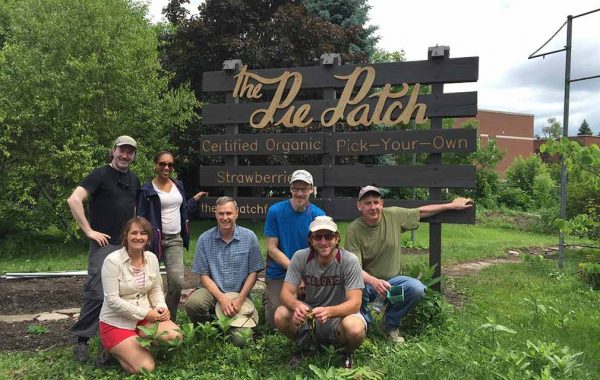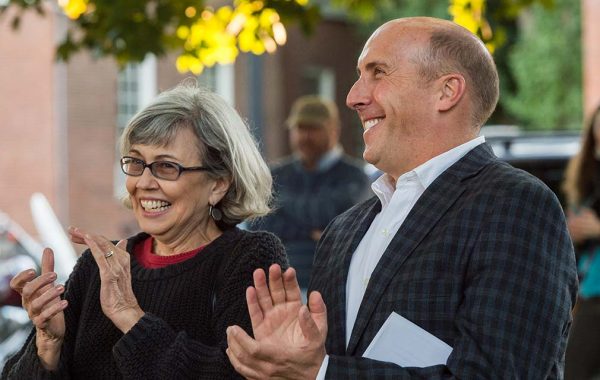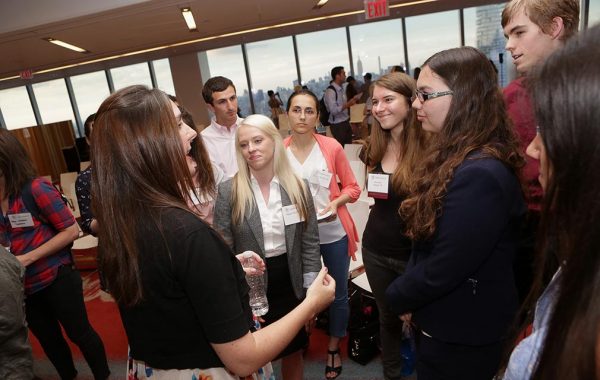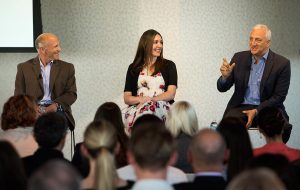The Office of Alumni Relations is pleased to offer many ways for alumni to stay in touch with each other, and with Colgate! E-mail me with questions or concerns at tmansfield@colgate.edu. — Tim Mansfield, associate vice president, institutional advancement and alumni relations. Questions? Contact alumni relations: 315-228-7433 or alumni@colgate.edu

Top row: Professors Antonio Barrera and April Baptiste. Bottom: Breanne Heath (owner of the Pie Patch) and professors Chris Henke, Rob Nemes, Mark Stern, and Peter Rogers. Photo by Chris Henke
Feeding faculty knowledge
This summer, a group of professors traveled cross-country to learn more about different food systems and how food history relates to other issues, such as inequality, gentrification, and deindustrialization. During their 11-day trip in June, they stopped in St. Louis, Detroit, and Chicago.
In the Windy City, they first visited Cortney Ahern ’10 at the headquarters of Feeding America. Ahern is a project manager at the nonprofit, working with a nationwide network of food banks to fight hunger. She’s also a former student of sociology professor Chris Henke, who coordinated the trip.
Ahern and her colleagues spoke to the professors, who represented a variety of disciplines, about food security — access to food that’s nutritious, plentiful enough to satisfy a healthy diet, and culturally appropriate.
“Cortney is food savvy and knows a lot about these issues, so it was natural for us to go to Feeding America,” said Henke, who’s kept in touch with Ahern ever since she took his Food class in 2009.
The other professors on the trip included Ben Anderson (economics), April Baptiste (environmental studies), Antonio Barrera (history), Rob Nemes (history), Peter Rogers (university libraries), and Mark Stern (educational studies). Henke had invited anyone whose interests, research, or teaching were connected to food.
Later in the day, the group met with approximately two dozen alumni from the Colgate Club of Chicago at the home of Linda Havlin ’72. Henke gave an overview of the trip, and then each professor shared something that was meaningful about the experience.
The trip was backed by the Kallgren Fund, which supports faculty interests and professional development.
“There are so many ways in which this trip is going to influence my teaching, especially in my Food class,” said Henke.
President Casey addresses Chenango club

Photo by Mark DiOrio
At the Club of the Chenango Valley’s first meeting this academic year, guest speaker President Brian W. Casey laid out his areas of focus for the university.
“I think our fundamental act — my charge — is first to attract an extremely strong faculty to Colgate, support them in their research, [and] help them as they develop as teachers,” he said. “Then assemble a strong group of students and educate them through a strong curriculum.”
Casey also talked about continuing diversity efforts and investing in the arts at Colgate.
A record crowd of more than 50 people attended the luncheon in September at the Colgate Inn. It was the first time many of the members had the opportunity to meet or hear from Casey.
“As I have seen him do with other audiences, he captured everyone’s full attention the whole time he was speaking,” said Sue Dolly Lathrop ’88, Colgate’s senior associate dean for admission operations, who introduced Casey at the luncheon.
“I absolutely love this village,” Casey said. “I think it is beautiful, warm, and engaging. I hope that I am here for many, many years.”
President Casey will visit several cities across the country for events with alumni and parents this academic year. See the events calendar for details.
Astronauts help launch STEM network

NASA scientist Jennifer Heldmann ’98 visits with students and alumni. Photo by Gerard Gaskin
“Who needs the moon when we got the stars?” It’s a question for the ages — one that Colgate community members working in STEM fields asked as they helped to launch the new Science, Technology, Engineering, and Mathematics Professional Network in New York City in May.
The event featured a panel conversation with NASA scientist Jennifer Heldmann ’98, a member of the Mars 2020 rover mission instrument team. Former astronaut Mike Massimino was also on the dais. He’s a veteran of multiple trips to the Hubble Space Telescope and author of the forthcoming book Spaceman: An Astronaut’s Unlikely Journey to Unlock the Secrets of the Universe. The talk was led by Jeff Bary, associate professor of physics and astronomy.
Events sponsored by the Colgate Professional Networks move careers forward, expanding community connections by sparking dialogue around points of common interest. Here’s a sample of the discussion that took place in New York at the STEM launch.
On women in STEM
Bary: We [in the discipline] have been working really hard for the last several decades to try and reach even numbers of men and women in astronomy, and we’re making pretty good progress.
Heldmann: I realize that, in order for women to be able to have these careers and be able to excel, you really need to have women in management positions, because that’s where the decisions are made … people who can appreciate what needs to happen so that you can have your career and a balanced personal life as well. I think NASA, as an agency, does a very good job of that. I do things now to help girls who are coming up from high school. NASA has a program called Girls, in which you mentor a middle-school student, she does a project, and you have Skype conversations. They have a Women in NASA group where people get together and discuss things. So there are things happening, and I now appreciate the value of them even more.
Bary: One of the most visible things that I think our culture has been aware of is women astronauts. I think of Sally Ride, Judith Resnick, and Christa McAuliffe. When I was ten to thirteen years old, they were such visible and recognizable names and figures — they did such important work to help break that barrier.
Heldmann: That’s a good point. You need to have that visual representation of, yes, this is possible.
The budget for blastoff
Bary: NASA began as a program in 1958, and during the moon program, the budget for NASA as a percentage of the GDP had gone up to more than 4 percent. It has steadily fallen to where it is today, which is at roughly .5 percent. How do we reverse that trend? Because I don’t think that, at .5 percent of GDP, we’re going to get to Mars.
Massimino: I think the only way we can get to Mars is if we were to try to do it as an international effort… The moon program was a U.S. program, whereas the International Space Station has us working with the Russians and working with the European Space Agency, Canada, and Japan. We’re able to pool resources, talents, and money to do things.
Heldmann: SpaceX says that they’re going to launch their Red Dragon capsules to Mars in 2018. So, at NASA, we have a Space Act Agreement to try and put payload on some of those capsules. They have been coming to us, the scientists, saying, “We don’t know where the water is [on Mars], so can you tell us?” And, yes, we can. It’s a nice example of NASA working with the commercial industry, and I think it’s a good model to follow.
The driving force (beyond rocket fuel)
Bary: In your future work, what do you hope to discover? What’s your most ambitious research goal?
Heldmann: I’m in it to try and address the astrobiology question. That’s a lot of the mission proposal writing that I work on — proposing missions to go to these very compelling locations in the solar system to look for life. Because one of the questions is: Is there a common origin of life within our solar system? And then you can extrapolate throughout the universe as well. Does all life have the same biochemistry? Are we all on the same tree of life? Or, was there some independent origin of life that occurred on Mars, on Enceladus, on some other planet elsewhere that we don’t even know about yet? Once you can grasp that concept, you can start thinking about how common life would be throughout the universe.
Bary: What about your experience orbiting the planet impacted you the most, and what was that impact on you as a person and your perspective on life?

L to R: Professor Jeff Bary, Jennifer Heldmann ’98, and former astronaut Mike Massimino. Photo by Gerard Gaskin
Massimino: The view where I was at Hubble. It’s a hundred miles higher than the station, so you see a little bit more of the curve of the planet, and it’s like looking into heaven. I know there almost has to be some other place where there’s life, and maybe there’s another place like this, but when I actually looked at Earth, I wasn’t so sure. I don’t see how you can have any place as beautiful as this. And when you see how perfect it looks, and then you turn your head and you see blackness for a pretty long way — it’s made me appreciate how lucky we are to live here. I know there’s a lot of bad stuff going on in the world, but it’s really a beautiful place to live.
Learn more about Colgate Professional Networks.






